Best Thunderbolt docks 2023: Extend your laptop’s capabilities
A Thunderbolt dock is now nearly a must-have accessory, providing I/O access for legacy mice, keyboards, external drives, and more. It’s a key ingredient for a productive office, whether at work or home.
Thunderbolt docks or docking stations help fill the gaps as laptop makers slim down, cut costs, and eliminate multiple ports in favor of a do-it-all Thunderbolt port instead. That may seem like they’re pushing those costs on to you (which they are) but it also means you can pick and choose a dock with exactly the ports you need.
Why buy a Thunderbolt dock? Because of the bandwidth it provides: 40Gbps, versus the 10Gbps a basic USB-C port offers. (You’ll see a small lightning bolt printed on your laptop, the cable, and the dock to signify that they’re Thunderbolt capable.) This offers enough bandwidth to connect up to two 4K displays at a comfortable, standard 60Hz refresh rate, plus all the peripherals you need like a printer, mouse, keyboard, and storage. Good Thunderbolt docks can also charge your smartphone.
This roundup begins with the very best Thunderbolt docks, including budget options. We’ll close by recommending our favorite DisplayLink USB-C docks—simpler, cheaper solutions that have recently emerged. Our best USB-C hubs and dongles are covered in a separate story. Confused? Don’t be. We’ll explain the differences in the FAQ that follows our recommendations, clarifying the terminology to help you understand what to buy and how to save some money, too.
Note that not every Thunderbolt dock we review appears here. Satechi’s Thunderbolt 4 Dock is our most recent review, but it failed to make the cut. We had a much more favorable view of the Anker 568, however, which we named as our favorite USB4 dock. Read our summary of this dock below to learn why it gives Thunderbolt docks a run for the money.
Best Thunderbolt docks
Plugable TBT3-UDZ Thunderbolt 3 Docking Station – Best overall Thunderbolt dock

Pros
- Tons of ports
- Space-saving vertical stand
Price When Reviewed:
$369.00
Plugable’s TBT3-UDZ is simply one of the best Thunderbolt 3 docks we’ve tested, with a boatload of ports. It’s expensive, however.
On the front, the TBT3-UDZ includes a 10Gbps USB-C and a 10Gbps USB-A (USB 3.1) port, microSD and SD card slots, plus a headphone jack. On the rear, five USB-A (USB 3.0 ports) and gigabit ethernet complement a pair of DisplayPort 1.4 ports and HDMI 2.0 ports. (It’s all based on Intel’s Titan Ridge chipset.) A 29-inch 40Gbps Thunderbolt 3 cable connects the dock to your laptop, and is capable of delivering 96W of power. Naturally, this is a powered dock, with a hefty 170W (!) charger.
Read our full
Plugable TBT3-UDZ review
IOGear Quantum Dual Mode Thunderbolt 3 Dock Pro (GTD737) – Best budget Thunderbolt dock
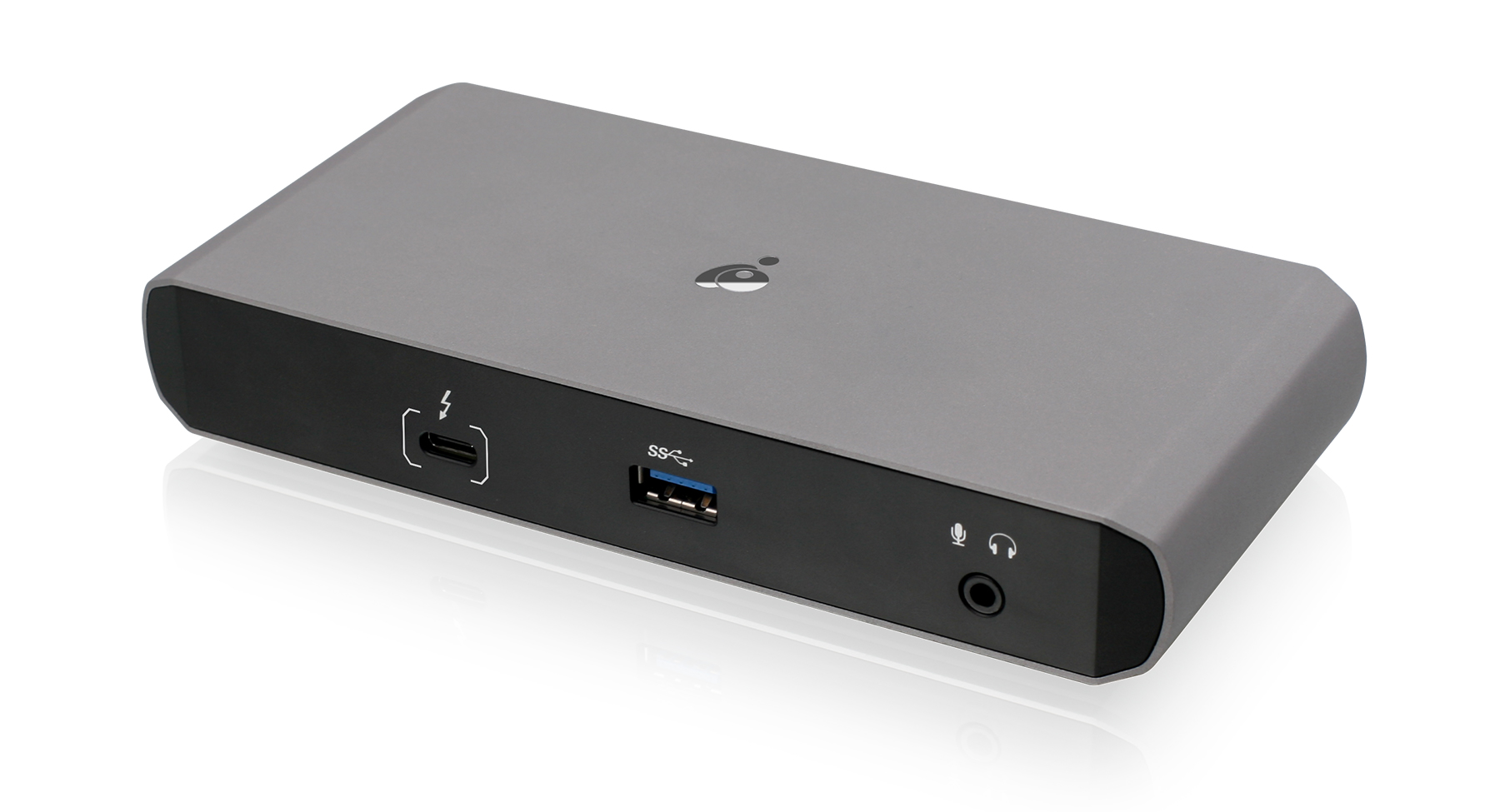
Pros
- Great mix of features
- Budget price
- 60W of passthrough charging power
Cons
- Two DisplayPort ports limit display I/O options
- Might be difficult to find in stores
Price When Reviewed:
308.45
About the only knock against IOgear’s GTD737 is its use of two DisplayPort 1.2 ports on the rear of the dock, which serve as the only dedicated display outputs. (We suspect HDMI is more popular.)
Otherwise, this dock is excellent, providing almost all the features you’ll want at an affordable price: a 10Gbps USB-A port on the front for 7.5W smartphone charging; on the rear, two 5Gbps USB-A ports for legacy mice and keyboards and two 10Gbps USB-C ports for further expansion. There’s also a gigabit ethernet port and a headphone jack. The 2.3-foot Thunderbolt 3 cable supplies 60W for your laptop via the associated 135W power brick. Performance details can be found in our review.
Note that this dock is essentially identical to the Kensington SD5500T (review), which at press time was priced slightly higher. Double-check our review to make sure.
Read our full
IOGear Quantum Dual Mode Thunderbolt 3 Dock Pro (GTD737) review
Plugable TBT3-UDC3 Thunderbolt Dock – Best overall Thunderbolt dock runner-up
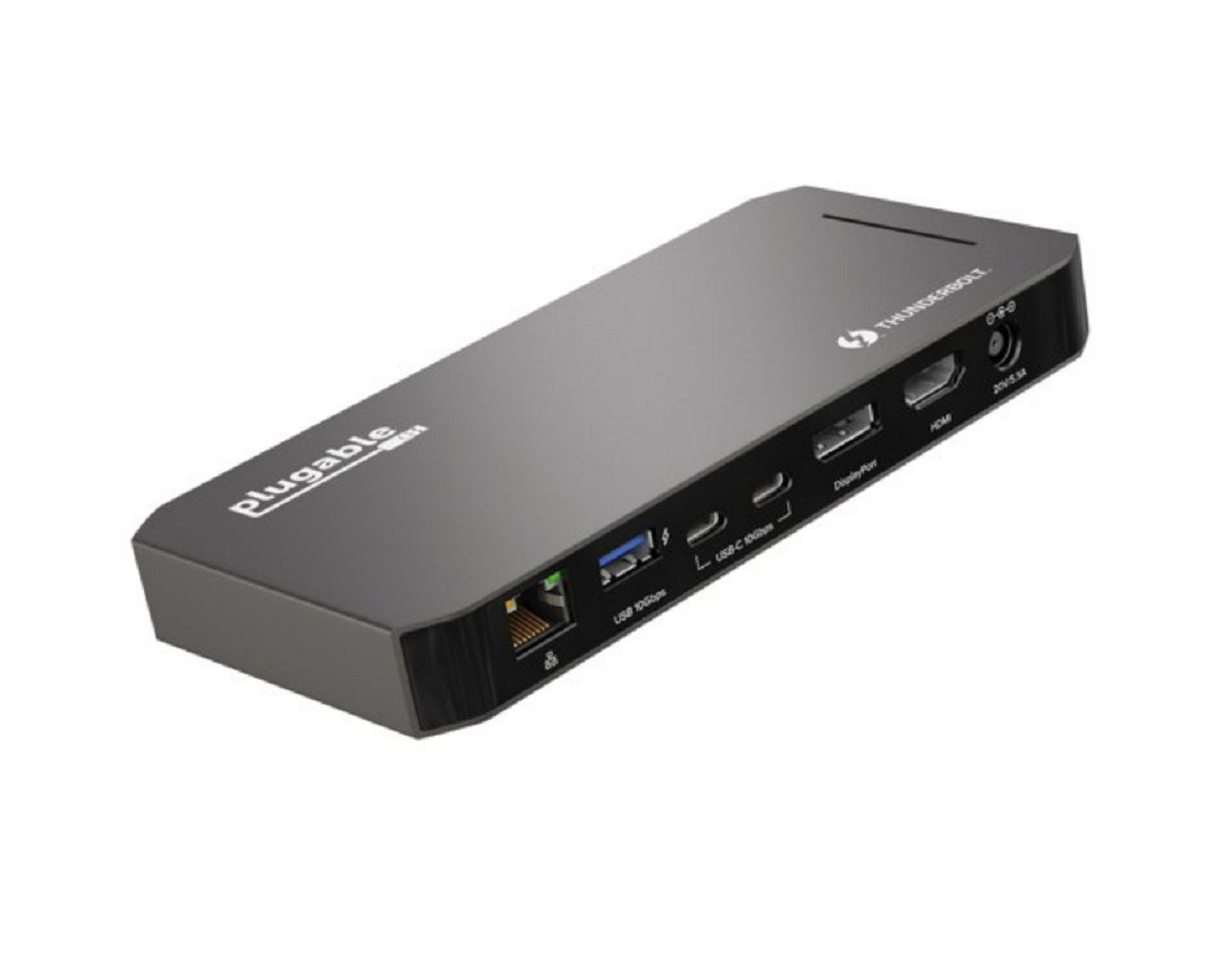
Pros
- A less expensive version of the Plugable TBT3-UDZ
- Supplies 96W of power
Cons
- Just two display ports, but an adapter dongle is included
Price When Reviewed:
$269.99
Plugable’s TBT3-UDC3 is a smaller, less-expensive version of the TBT3-UDZ, with less I/O flexibility but more focus. The dock includes a pair of USB-A 5Gbps ports on the front for a mouse and keyboard, and then a second USB-A (10Gbps) port on the back. A pair of two 10Gbps USB-C ports sit alongside it for further expansion. There’s gigabit ethernet, too. Smartly, Plugable includes one HDMI 2.0 port and a DisplayPort 1.4 port for display connections, plus an HDMI-to-DisplayPort dongle in the box in case you own two HDMI displays.
Read our full
Plugable TBT3-UDC3 Thunderbolt Dock review
Belkin Thunderbolt 3 Dock Core – Best budget Thunderbolt dock runner-up

Pros
- Compact
- HDMI 2.0 + DisplayPort 1.4 port covers two displays
Cons
- Unlabeled USB-A ports look identical
- Bus-powered
Price When Reviewed:
$199.99
Belkin’s Thunderbolt 3 Dock Core is a smartly designed “powered” Thunderbolt 3 travel dock, and an inexpensive one as well.
At a nearly square 5.2 x 6.5 x 1.5 inches, the Thunderbolt Dock Core black doesn’t take up much room, and the included 8-inch Thunderbolt 3 cord provides ample length for flexibility. Ports are adequately spaced around the flat, black plastic cube, with HDMI 2.0 and DisplayPort 1.4 ports providing a stable 4K/60Hz experience to both of my 4K displays. There’s gigabit ethernet and a 3.5mm audio jack, but good luck telling the USB 3.1 and USB 2.0 Type A ports apart—they’re not labeled.
Read our full
Belkin Connect Thunderbolt 3 Dock Core review
HP Thunderbolt Dock 120W G4 (4J0A2AA) – Best Thunderbolt dock for business
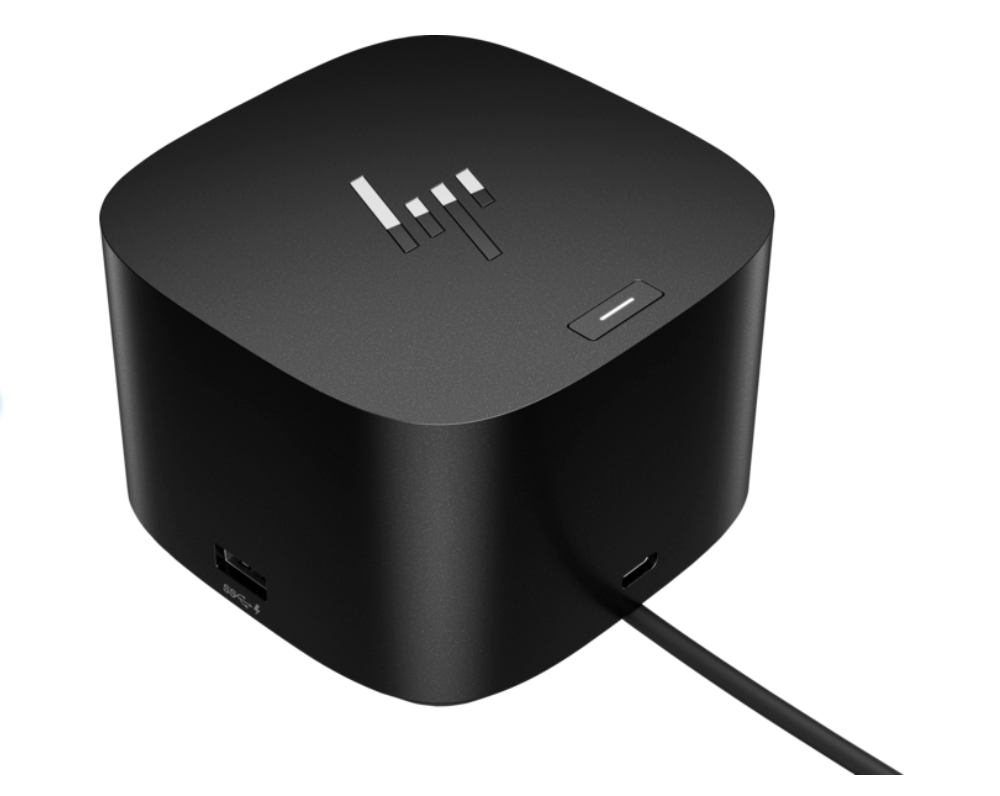
Pros
- Ports aplenty, plus charging
- Solid performance
- No thermal concerns
Price When Reviewed:
$369.00
This squat little Thunderbolt 4 dock feels a lot more solid than its rated 1.68 pounds would indicate, and sprouts ports to all sides: a 10Gbps USB-C port capable of 15W charging on the front, a 5Gbps USB-A port on either side, plus two more on the back, all capable of 7.5W out. The back also houses two DisplayPort 1.4 ports, an HDMI 2.0 port, ethernet, and a USB-C 3.2 Gen 1 port designed for video. We only tested this dock with two 4K/60 external displays, but it’s capable of driving three 4K/60 displays provided you have a DisplayPort 1.4-capable laptop with Display Stream Compression, or DSC.
The 4J0A2AA supplies up to 100W to the host laptop via the Thunderbolt cable—still among the highest we’ve seen. Even then, there were no thermal issues at all.
Read our full
HP Thunderbolt Dock 120W G4 (4J0A2AA) review
Kensington SD5780T Thunderbolt 4 Docking Station – Best Thunderbolt 4 dock

Pros
- Solid performance
- 96W (rated) of downstream laptop power
- Pretty solid mix of ports, including downstream Thunderbolt 4
Cons
- One of the most expensive docks we’ve tested
- Rear USB-A ports deliver less power than expected
- One display port, requiring an additional dongle for two displays
Price When Reviewed:
$399.99
The Kensington SD5780T replaces the Kensington SD5700T as our pick for the best premium Thunderbolt 4 docking station right now, but the price is also extravagantly high. (Amazon knocked 15 percent off the price at the time of our most recent revision, though, lowering the price considerably.)
The SD5780T improves on its predecessor by adding a dedicated HDMI 2.1 port and more laptop charging power. The dock performed excellently in our tests, though the external power was a bit lower in places than we’d hoped. (It counts where it matters, however, which includes charging a smartphone.)
Read our full
Kensington Thunderbolt 4 Dual 4K Dock (SD5780T) review
OWC Thunderbolt Dock Go – Best Thunderbolt 4 dock, runner-up
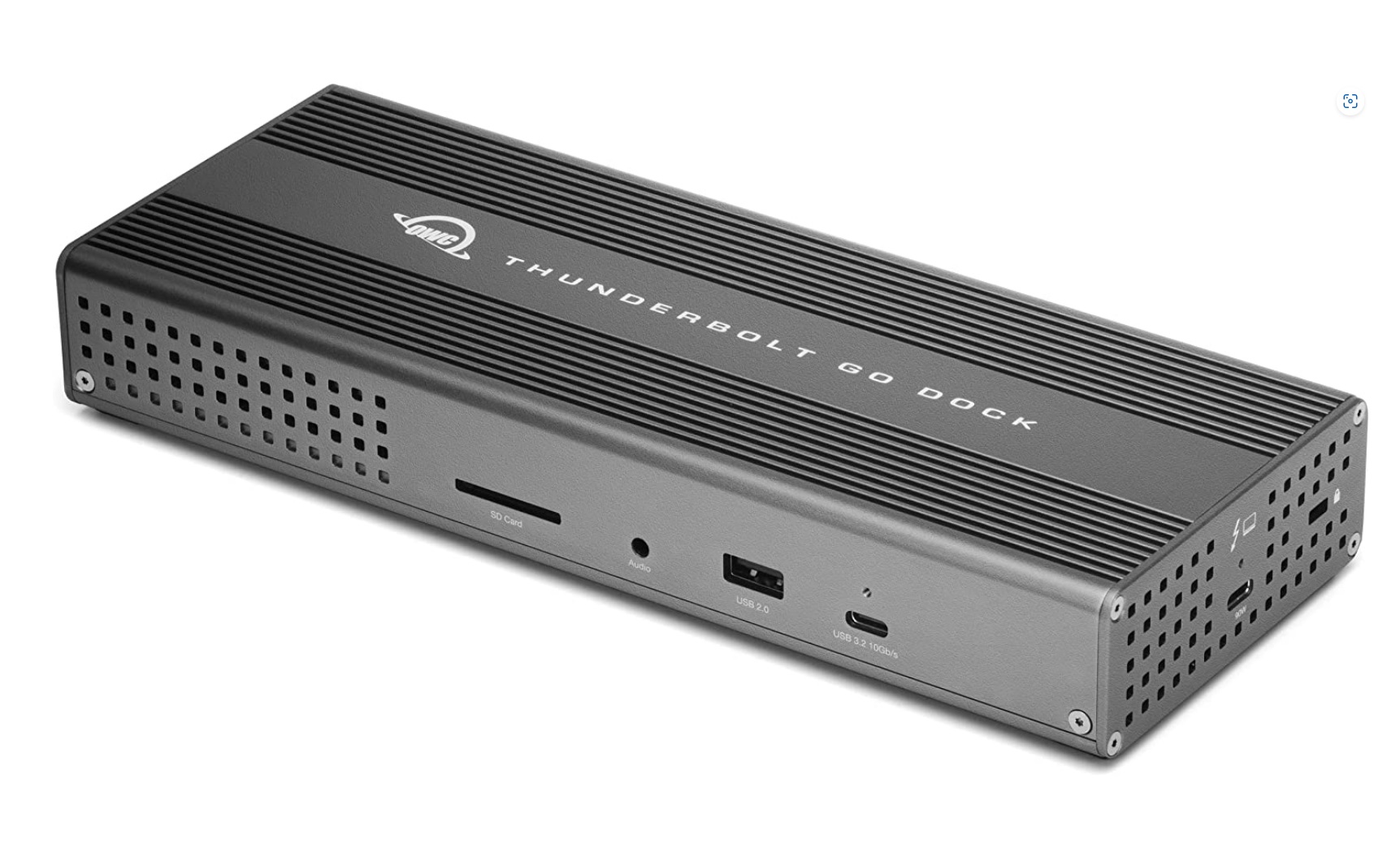
Pros
- Power brick is hidden within, removing clutter
- 90W to charge your laptop
- Supplies a terrific 9.5W for smartphone charging
- HDMI 2.1 support
Cons
- Ethernet is glitchy, and requires a driver
- Bulky
- Expensive
- Limited built-in display options
Price When Reviewed:
$349.99
OWC’s Thunderbolt Dock Go has an immediate selling point: Its power brick is integrated, like a desktop PC, saving space in your bag. It’s still a bit big for a travel dock, though.
About the only concerns we had with this dock were the initial glitchiness with the ethernet (now, apparently, solved) and the high price, which may come down over time. That includes the possible need for a display dongle (sold separately), which you may need to connect a second display. Otherwise, it’s a solid effort from OWC. You can read more about it in PCWorld’s own review of the OWC Thunderbolt Go as well as on our sister site, TechAdvisor, which agrees.
Plugable 5-in-1 Thunderbolt Hub (USB4-HUB3A) – Best Thunderbolt 4 hub
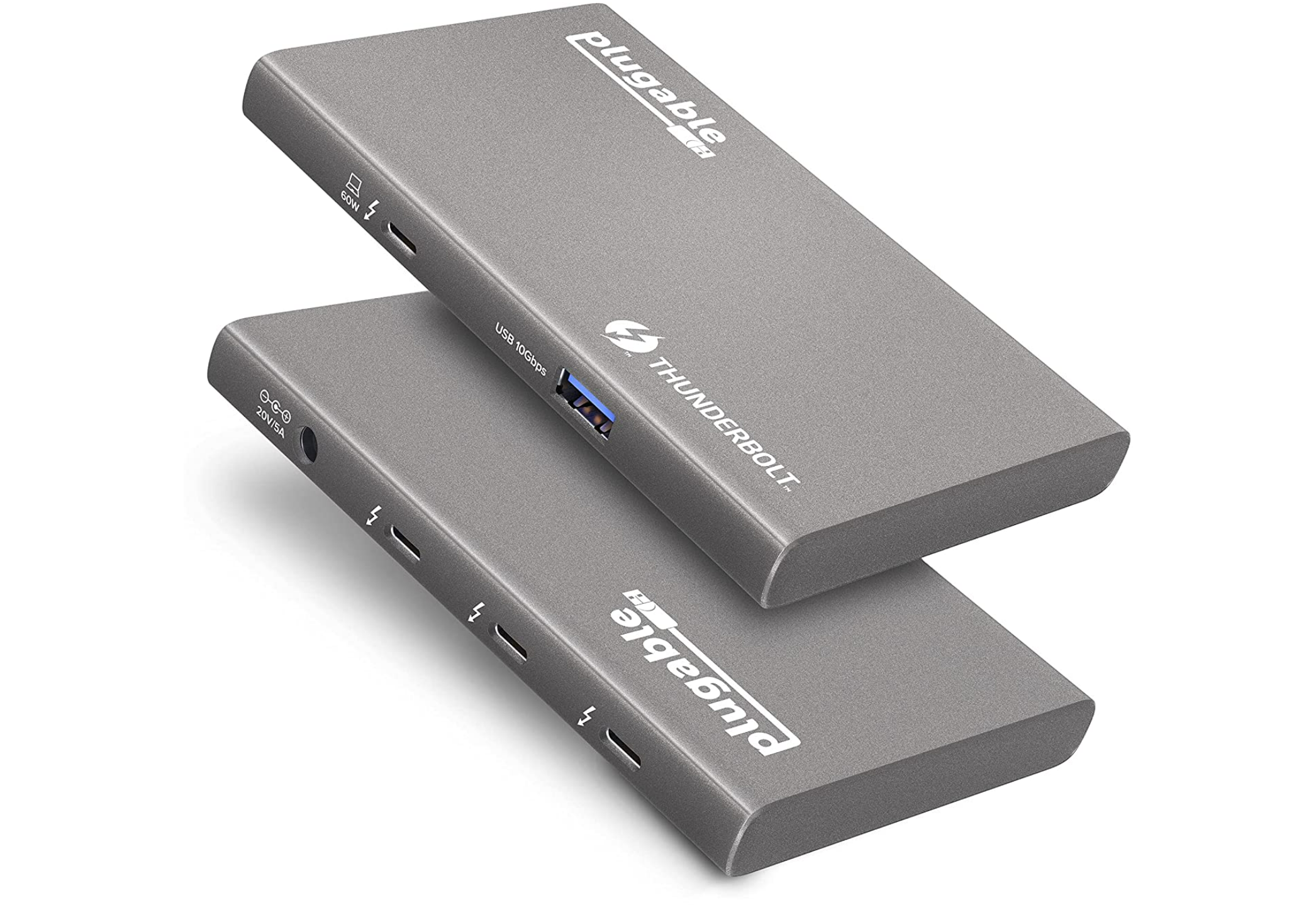
Pros
- Incredibly compact
- USB-C to HDMI adapter included
- 15W/60W of charging power to phones/PCs
Cons
- Limited ports
- Best for Thunderbolt-attached displays
Price When Reviewed:
$189
The Mac world tends to emphasize Thunderbolt-connected displays far more than the Windows world does, so this might be a niche product for most of you. But this thing is tiny (4.75 x 2.88 x 0.5 inches) even if, unfortunately, the associated power brick isn’t. It will send 15W of power via the Thunderbolt/USB-C connections to charge smartphones, and 60W to the host PC.
We lacked a Thunderbolt-connected display at the time of testing. (We have one now, and can confirm it works.) But the box does include a USB-C to HDMI adapter, so you can certainly connect one display natively out of the box, then attach a USB-C hub to connect another.
Read our full
Plugable 5-in-1 Thunderbolt Hub (USB4-HUB3A) review
Anker Apex 12-in-1 Thunderbolt 4 Dock – Best Thunderbolt dock for HDMI displays
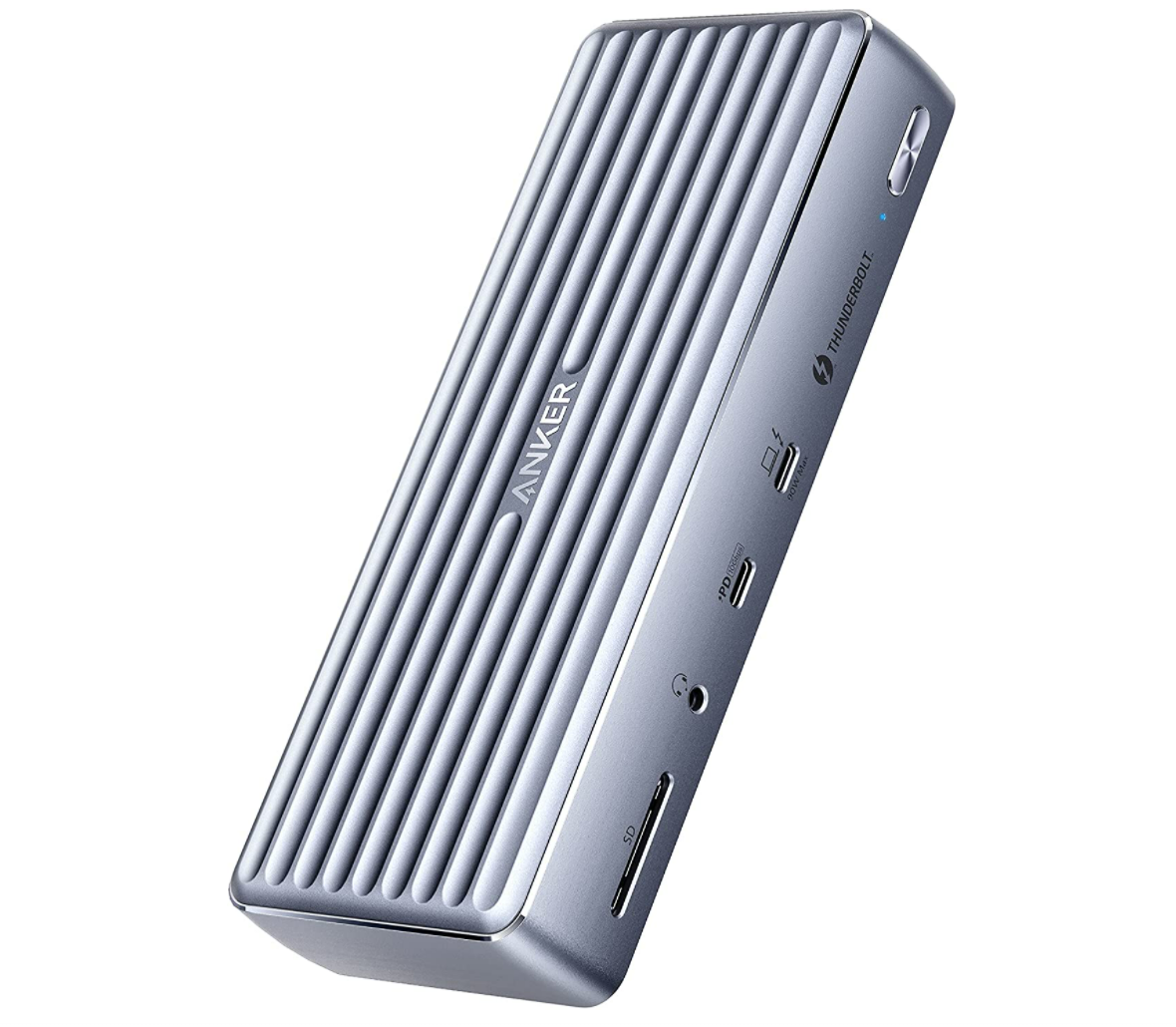
Pros
- Two HDMI ports
- An extra 40Gbps downstream Thunderbolt 4 port
- Power button
Price When Reviewed:
$299.99
The Apex Thunderbolt 4 Dock features one 40Gbps upstream TB4 port (that connects to the computer with the included Thunderbolt 4 cable) and one 40Gbps downstream TB4 port for other devices, such as a fast SSD storage drive. The upstream Thunderbolt port can supply up to 90W of power to your laptop, while the downstream port can charge other devices at 15W.
Anker’s inclusion of two HDMI ports means you don’t need any adapters to connect displays, provided you own two with HDMI connections. In total, the dock supports the two Thunderbolt 4 ports, two USB-A ports (10Gbps, 4.5W of power), another two USB-A ports (480Mbps, 4.5W), and a USB-C port (10Gbps, 20W) alongside gigabit ethernet, a UHS-II SD card reader, and a 3.5mm headphone jack. The dock is powered, with a 120W power supply.
Really, this is a perfectly useful Thunderbolt 4 docking station that challenges our top-ranked Thunderbolt docks. If the price is right, consider it.
Read our full
Anker Apex 12-in-1 Thunderbolt 4 Dock review
Anker 568 USB-C Docking Station – Best USB4 docking station
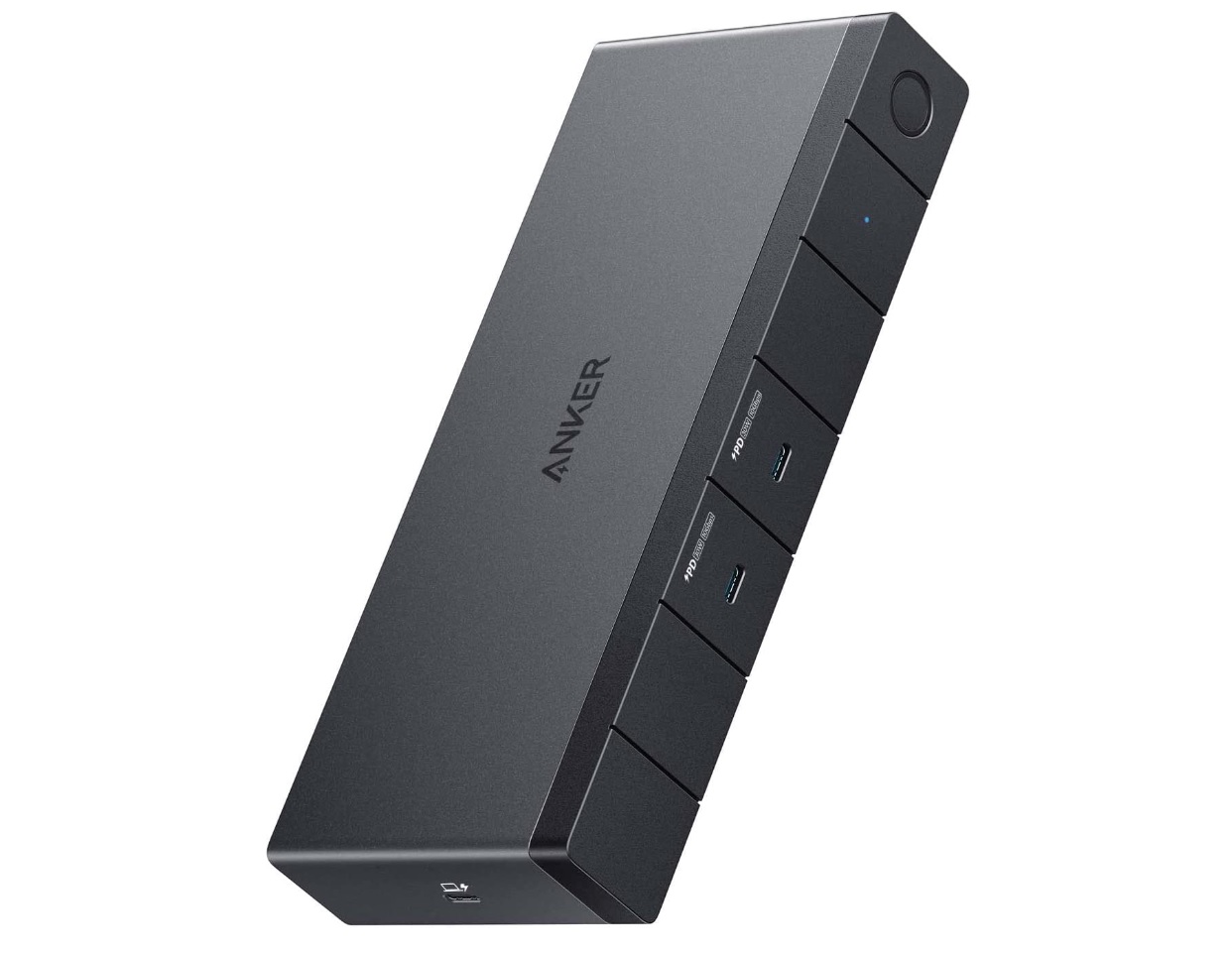
Pros
- Two ports for fast-charging smartphones
- Solid value
- Eighteen-month warranty
Cons
- Occasional instability on a second display or connected devices
Price When Reviewed:
$299.99
A USB4 docking station is very much like a Thunderbolt 4 docking station—you can see more explanation following our roundup of best picks. But if you’re specifically looking for a USB4 docking station, you should buy the Anker 568 USB-C Dock.
This 11-in-1 docking station favors DisplayPort, with two DisplayPort 1.4 ports, and a single HDMI 2.0 video port. The Anker 568’s distinguishing feature, however, is the pair of 10Gbps USB-C ports on the front, with each supplying 30W of power as well as a separate 100W connection to the laptop. That’s quite unusual, and the two ports should fast-charge a smartphone and possibly even a tablet.
We noticed a small bit of instability on occasion, but in general the Anker 568 provided a solid connection to a pair of 4K displays and other peripherals.
Read our full
Anker 568 USB-C Docking Station review
CalDigit Thunderbolt Station 3 Plus (CalDigit TS3 Plus) – Most flexible Thunderbolt dock for I/O
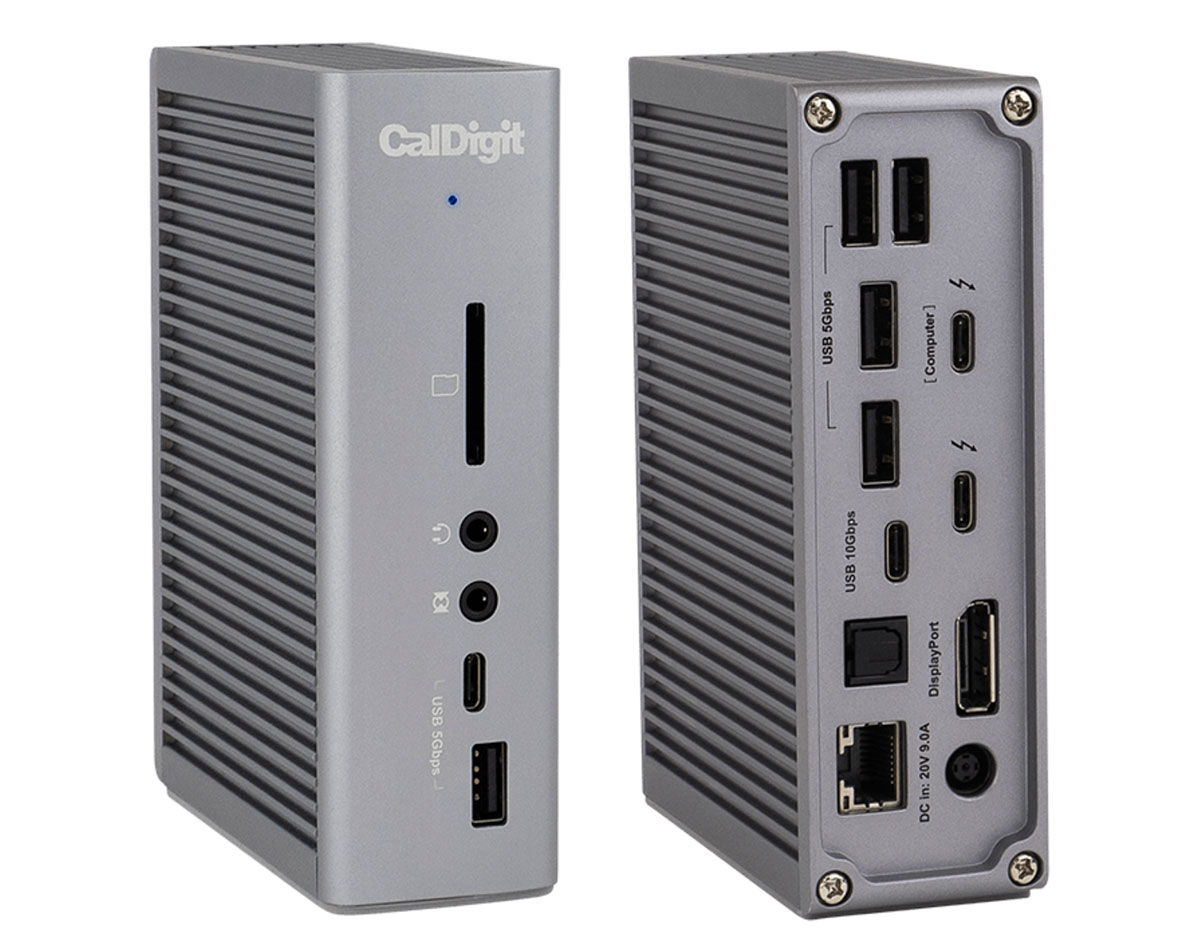
Pros
- Ports, ports, ports
- Vertical orientation, no stand necessary
Cons
- Only a single DisplayPort port
Price When Reviewed:
$299.95
CalDigit’s Thunderbolt Station 3 Plus is one of the most popular Thunderbolt 3 docks available, and it’s easy to see why: a space-saving vertical orientation, 87W charging, gobs of available ports, and even niceties like a S/PDIF optical connection and an external Thunderbolt jack for daisy-chaining devices.
Port selection includes: two Thunderbolt 3 ports (one from the laptop, and one for an external connection), and a single DisplayPort 1.2 port. That’s ideal for a single 4K display, but awkward for two. The TS3 Plus includes one full-sized SD (SD 4.0 UHS-II) card reader, the S/PDIF port, gigabit ethernet, and two 3.5mm audio jacks—one in, one out. Five USB Type A ports are also included (all 5Gbps USB 3.1 Gen 1) and two USB-C ports (one 5Gbps port, and one 10Gbps port).
CalDigit Thunderbolt Station 4 (TS4) – Best for Apple Mac users
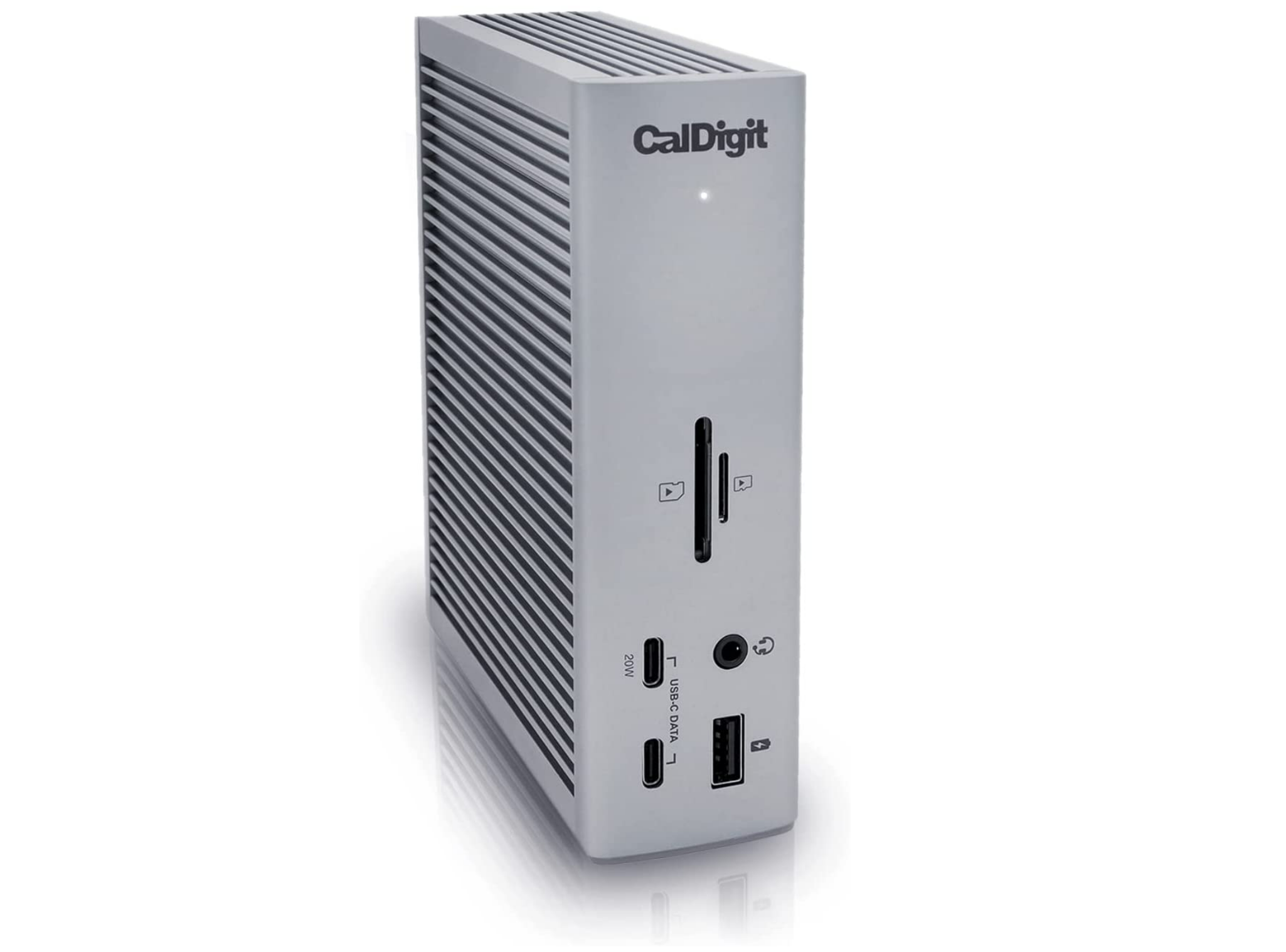
Pros
- Thunderbolt 4
- A whopping 18 ports
- 98W power delivery to your Mac
- 2.5 gigabit ethernet
- 230W power supply
Cons
- Only two downstream TB4 ports
- Pricey
Price When Reviewed:
$399.95
This recommendation comes courtesy of our colleagues at Macworld, who have compiled their own list of best Thunderbolt docking stations for the Apple Mac market. “All the ports you could want coupled with high-wattage charging justify the price of this full-featured dock,” and who are we to argue? We can personally vouch for its progenitor, the TS3 Plus, which we ranked favorably among other Thunderbolt docks.
While we have yet to review the TS4 ourselves, a simple gander at the price re-affirms our certainty that this is a product for the Mac market.
Best DisplayLink USB-C dock
DisplayLink USB-C docks, which we discuss in more detail in our separate article, don’t offer enough bandwidth for high-refresh rate monitors or gaming, but they work admirably well for everyday office work, including watching movies. Anecdotally, they’ve often also been more stable than a Thunderbolt dock on older hardware, as sometimes Thunderbolt docks have issues “waking up” when the host laptop wakes up from standby.
What we’d like to see in a DisplayLink USB-C docking station is a feature set that approaches a full-fledged Thunderbolt dock, but that is priced below what you’d pay for Thunderbolt performance. Our current pick does just that.
Plugable USB-C Dual 4K Display Horizontal Docking Station (UD-6950PDH) – Best USB-C DisplayLink dock

Pros
- Terrific value for office workers
- Great display flexibility
- Plenty of USB-A ports
- SD/microSD card slots, too
- 100W of charging power
Cons
- No USB-C ports
- No dedicated charging ports
- DisplayLink doesn’t allow for full Thunderbolt bandwidth
Price When Reviewed:
$199.00
Plugable’s UD-6950PDH doesn’t allow the bandwidth for the latest HDMI or DisplayPort interfaces. But the dock preserves what we like about Plugable’s docks: two pairs of optional DisplayPort and HDMI connections to choose from, as well as 100W of charging power to your laptop. One omission, however, is a dedicated charging port for powering a smartphone, or any USB-C port at all.
At about $199 MSRP, however, the price is absolutely right. Just don’t forget your smartphone charger.
Read our full
Plugable USB-C Dual 4K Display Horizontal Docking Station (UD-6950PDH) review
FAQ
How do I know if my laptop has Thunderbolt?
The short answer: Look at the laptop’s published specifications to be sure. A Thunderbolt port may look indistinguishable from a USB-C port, since they both use the same physical USB-C connection. Put another way, all Thunderbolt ports are USB-C, but not all USB-C ports are Thunderbolt-equipped.
Thunderbolt ports are supposed to have a small lightning-bolt icon to identify them. But some laptop makers use a similar lightning-bolt icon to indicate that a USB-C port can be used for charging your phone, and not for Thunderbolt. Laptop makers sometimes don’t want to clutter the clean lines of their products by adding additional logos, it seems.
Adding to the confusion, you may also see USB-C hubs marketed as “Thunderbolt compatible.” That’s true. You can plug a Thunderbolt dock into a non-Thunderbolt, generic USB-C port. But it will be limited by the available bandwidth that the port provides, so it’s somewhat deceptive in that regard.
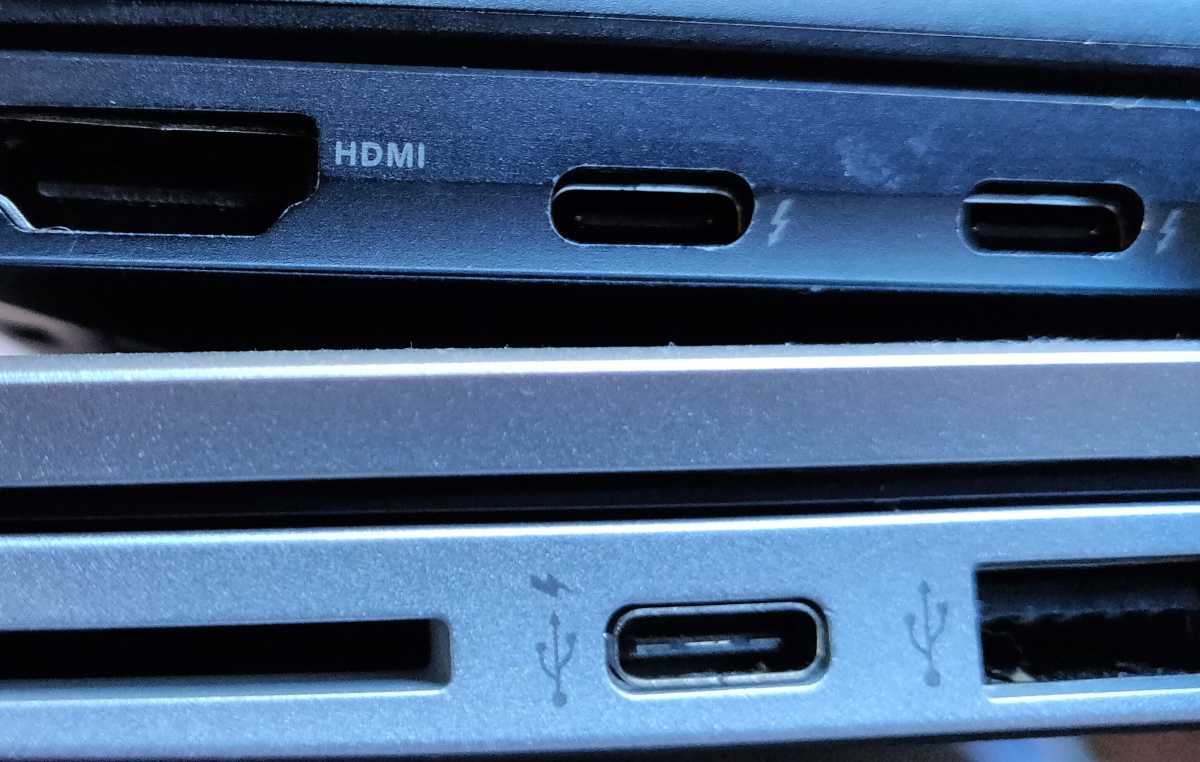
Two laptops, both with USB-C ports, and both with lightning-bolt symbols. Which laptop offers Thunderbolt? The top one, though it can be difficult to tell. Consulting the manufacturer’s specifications is your safest bet.
IDG
I already own a USB-C dongle. Can I use it with Thunderbolt?
A USB-C dongle won’t replace a Thunderbolt dock, as there’s circuitry within the dock that allows it to work your laptop’s high-speed Thunderbolt port. However, there’s nothing saying that you can’t connect the dongle to an available USB-C port on the Thunderbolt dock itself to add even more ports.
That solution will add more clutter to your desk, but it might allow you to buy a cheaper, budget dock, too. It’s up to you!
How fast is Thunderbolt?
40Gbps, basically.
Most USB-C ports are built on the second-generation USB 3.1 data-transfer standard, which transfers data at 10Gbps. Thunderbolt 3 and 4 ports, the most common standard, transfer data at up to 40Gbps. Thunderbolt 4 differs very slightly in that it supports a theoretical maximum of 32Gbps for external storage devices, but you probably won’t notice the difference.
There are very rare exceptions: A new USB 3.2 Gen 2×2 spec can pair two 10Gbps channels together, creating an aggregate 20Gbps hub. And while the vast majority of Thunderbolt 3-equipped laptops are designed with four PCIe lanes for a total of 40Gbps, some laptops only ship with two PCIe lanes for a total of 20Gbps. (A Dell support page, for example, details its four-lane and two-lane laptops.) Essentially, a 20Gbps connection should be enough for a single 4K monitor running at 60Hz, with a bit of extra bandwidth for other data transfers among connected peripherals.
In the real world, things are slightly more complicated. Essentially, Intel’s 10th-gen and 11th-gen Core chips launched in the early days of Thunderbolt, and company representatives say that you can depend on them for 32Gbps of data, not a full 40 Gbps. Intel’s 12th-gen and 13th-gen Core chips offer the most consistent Thunderbolt experience, with 40Mbps Thunderbolt 4 speeds, including 32Gbps for data transfers to and from storage devices.
Our next question describes the difference between Thunderbolt 3, 4, and USB4.
What’s the difference between Thunderbolt 3, Thunderbolt 4, and USB4?
The short answer: Not that much, and we consider Thunderbolt 3 docks and Thunderbolt 4 docks to be functionally equivalent for most users. The longer answer, which we’ll describe below, is that there are differences, and parsing the nuances can be confusing. Think of Thunderbolt 4 as the more restrictive version of Thunderbolt 3, with little room for any gotchas.
Essentially, Thunderbolt 3 and Thunderbolt 4 allow up to 40Gbps maximum bandwidth, enough for two 4K/60 displays. “Up to” is the key phrase: Thunderbolt 3 is only required to support a 10Gbps connection, allowing for a single external 4K display (a 16Gbps PCIe connection, paired with USB 3.2). Most manufacturers go beyond this, however, and our recommended docks support the full specification (and two 4K displays) unless noted. Thunderbolt 3 also supports a slower (16Gbps) PCIe connection for connecting to external storage.
Thunderbolt 3 is also the only specification (not Thunderbolt 4) that we’ve seen connecting to external GPUs, in case you’d like to try that approach.
Thunderbolt 4 doesn’t allow for any leeway—you’re getting a full-fledged 40Gbps connection (32Gbps PCIe + USB 3.2), no questions asked. For external storage, Thunderbolt 4 supports 32Gbps of data transfer—this really only matters for video, external GPU connections, or possibly games. Thunderbolt 4 supports “wake on sleep” from an external keyboard or mouse, which allows you to tap your external keyboard or wiggle your mouse to wake up your PC, which is handy. Thunderbolt 4 allows for longer cables and more Thunderbolt ports on laptops, too.
USB4 is essentially a subset of Thunderbolt 4, mainly designed as an an I/O specification. You’ll most often see USB4 appear on AMD laptops, and Thunderbolt on Intel laptops.
USB4 can only support one display, and manufacturers can choose whether it supports a 20Gbps connection or a 40Gbps connection, according to Thunderbolt dock designer Plugable. As a subset of Thunderbolt 4, a USB4 device will run just fine plugged into a Thunderbolt 4 port. But a Thunderbolt 4 device may not work as expected when plugged into what is specifically a USB4 port. Don’t worry about this too much, as it’s rare to see a USB4 hub. Instead, most hubs and docks are marketed as Thunderbolt 4, while most devices (like an external SSD) are designed around USB4.
USB4 Version 2 is an upcoming standard that will propel USB4 to 80Gbps, which is the only 80Gbps standard yet announced. The first products will debut (as a guess) in early 2023.
Note that Thunderbolt 3 and 4 require at least 15W to power devices plugged into the Thunderbolt port, such as a bus-powered hard drive. USB4 requires just half that.
Device maker Anker has a nice summary of all of the technical features associated with Thunderbolt 3, Thunderbolt 4, and USB4, if you really want to get into the fine distinctions (below).
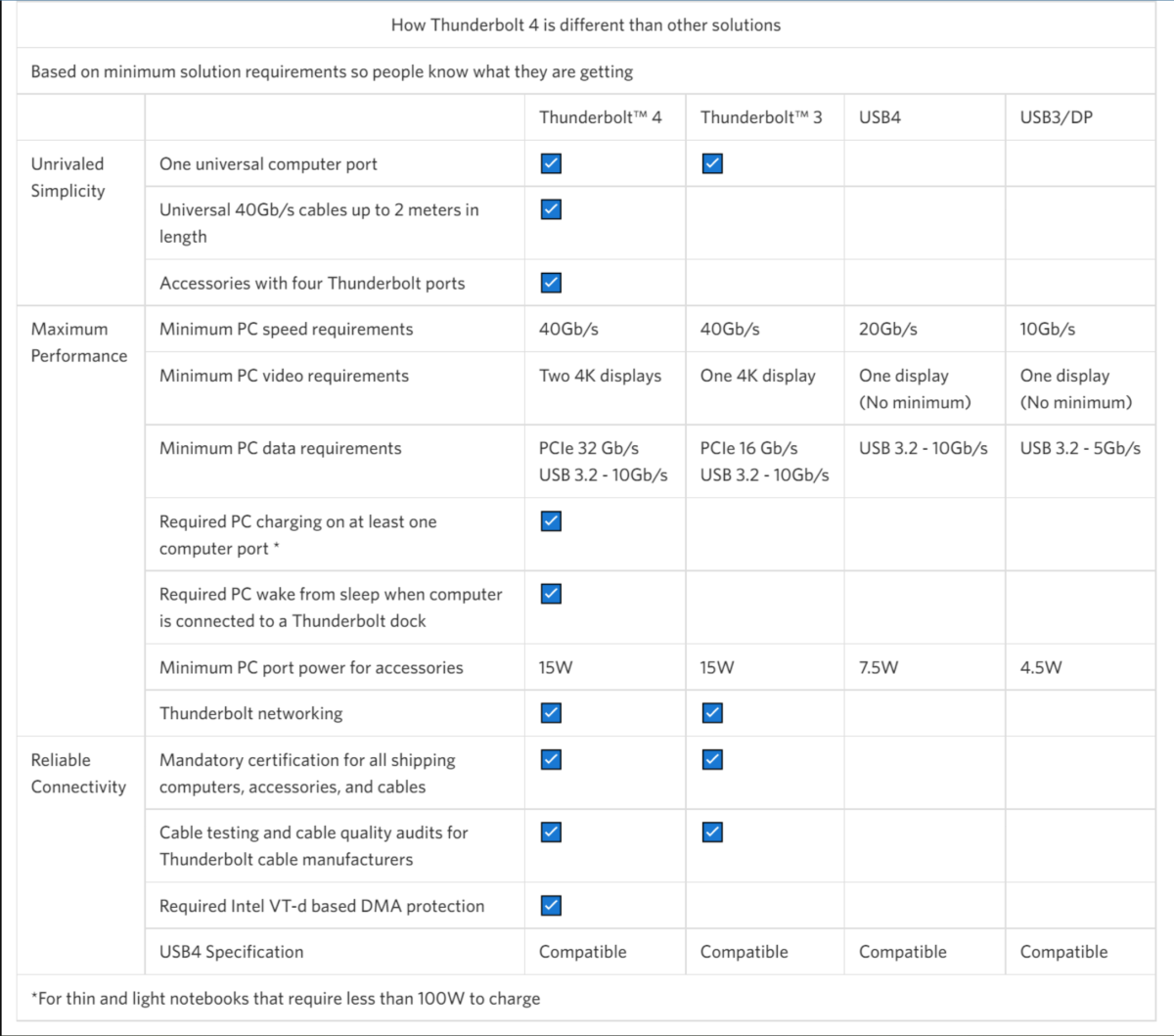
Thunderbolt dock and I/O hub designer Anker provided this summary of the differences between Thunderbolt 3 and Thunderbolt 4.
Anker
What cable should I use with a Thunderbolt dock?
Virtually every Thunderbolt dock will ship with its own cable. We’d recommend that you use Thunderbolt 3 cables with Thunderbolt 3 products, and Thunderbolt 4 cables with Thunderbolt 4 products.
What differentiates a DisplayLink USB-C docking station from a Thunderbolt dock?
A DisplayLink USB-C docking station is a new category of docking station. They’re often marketed just as a USB-C docking station, unfortunately, though the DisplayLink logo features prominently on the box. The key here is that the DisplayLink technology (now owned by Synaptics) uses software data compression between your PC and the dock to approximate a Thunderbolt experience (a pair of 4K displays at 60Hz, plus additional peripherals) across the narrower, slower USB-C bus. You’ll need to install a software driver to make it work.
The advantage here is twofold. First, DisplayLink allows you to “cheat” and get a Thunderbolt dock experience on an older laptop. Alternatively, even if you do own a laptop with a Thunderbolt port, you may be able to find a DisplayLink USB-C dock for a cheaper price than Thunderbolt. This is a viable solution, especially if you don’t mind not playing PC games.
Our separate story on DisplayLink docks has more.
Are there any other technologies that I need to know about?
We’re starting to see some USB-C docking stations take advantage of another technology: HBR3 (High Bit Rate 3) with DSC (Display Stream Compression). Think of it as the industry-standard, manufacturer-agnostic version of DisplayLink. It works over the USB-C port, and again provides a dual 4K60 display experience.
The problem? It’s wonky. We’ve found that support for the technology was very iffy in 11th-gen hardware, and really seems to work consistently in 12th-gen or 13th-gen Core laptops (and above, when they ship). While we can’t really recommend it right now, we’re keeping an eye on it.
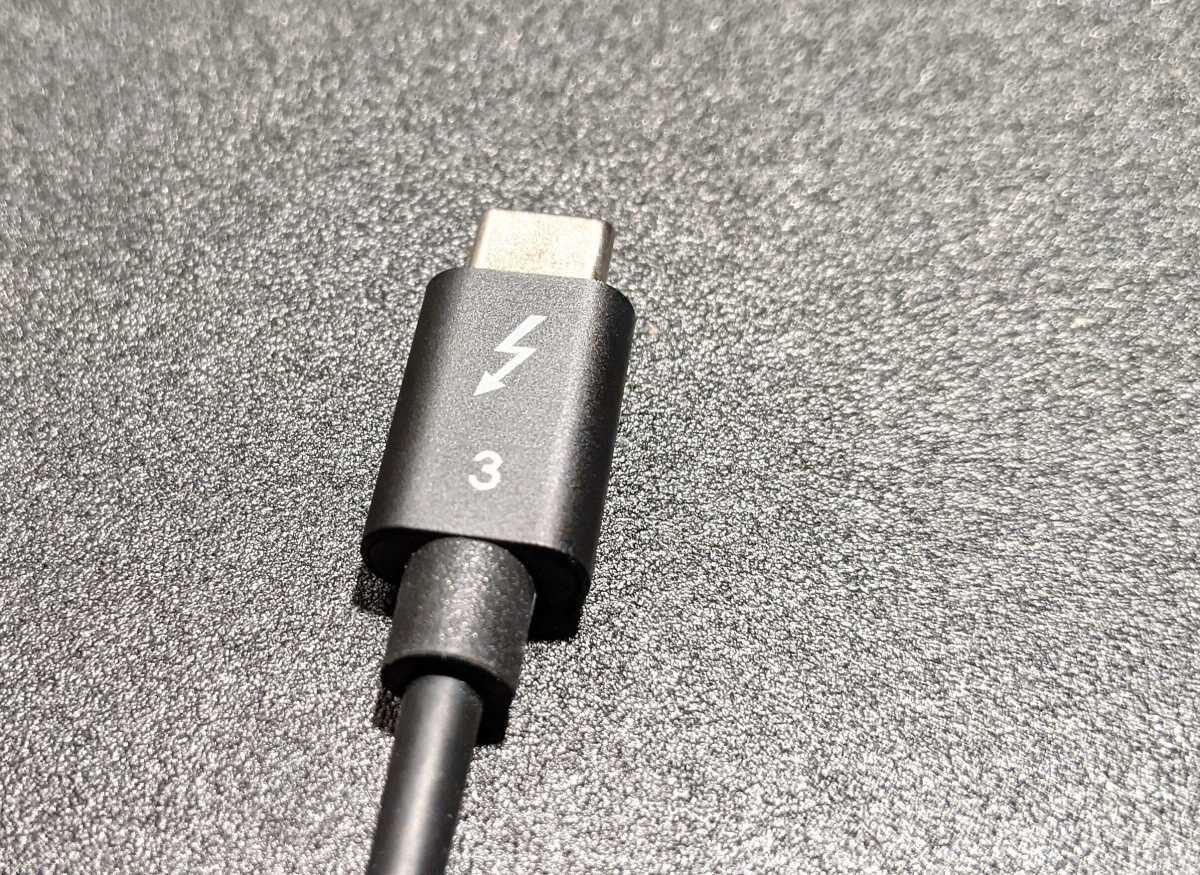
The vast majority of Thunderbolt docks should include a Thunderbolt cable like this one, which indicates that it’s specified for Thunderbolt 3.
IDG
Buying Guide: what to look for in a Thunderbolt dock
Ports, cables, peripherals: Those are the three major considerations when buying a Thunderbolt dock.
We’re beginning to see the Thunderbolt dock market break down in a few different ways. First, there’s the budget versus full-featured docks we’ve highlighted above. But you also may see something similar to the USB hubs of old: Devices that take Thunderbolt in and then provide several USB-C (including Thunderbolt) ports out. There are a small number of displays with Thunderbolt inputs, which can be plugged directly into these hubs. Do you have an existing cheap USB-C dongle? You can certainly plug that in into a Thunderbolt dock and add even more I/O functionality.
Basically, consider what you’ll want to plug into the dock as a guide for buying one. We prefer devices with ports built in (such as HDMI, USB-A, and so on) as the USB-C device ecosystem is still in its infancy. But ask yourself some questions. Do you want a basic Thunderbolt dock, with just a pair of HDMI ports for connecting two displays? Does an SD card slot matter? How many USB Type A peripherals do you plan to attach? Do you want to use the Thunderbolt cable to charge your laptop, too?
Cables can be an unexpectedly important consideration, too. Virtually every dock ships with a Thunderbolt cable. But consider the displays you own (typically HDMI or DisplayPort) and consider whether the dock will accommodate them.
Check your laptop’s power supply. Does it plug into your laptop via USB-C? If so, a Thunderbolt dock will likely power it. You’ll need to understand how the dock supplies power, though. Check your laptop’s charger to learn how much power it supplies, and how much the dock will need to supply to replace it. If your laptop or devices aren’t receiving enough power, you may see a warning pop up.
A “bus-powered” dock won’t come with an external charger in the package, saving some cost, space, and power concerns. A dock with “power delivery” will supply its own power and charge your laptop and/or a phone via your laptop’s existing USB-C charger. (Chances are that it won’t offer the quick-charging capabilities premium smartphones offer, though.) The more power your dock supplies, the greater the ability to charge your laptop and any bus-powered devices. This is a gotcha most people don’t think about, so if you plan to connect several bus-powered hard drives or SSDs, buy a dock with a hefty power supply. (USB keys, on the other hand, require tiny amounts of power. Don’t worry about these.)
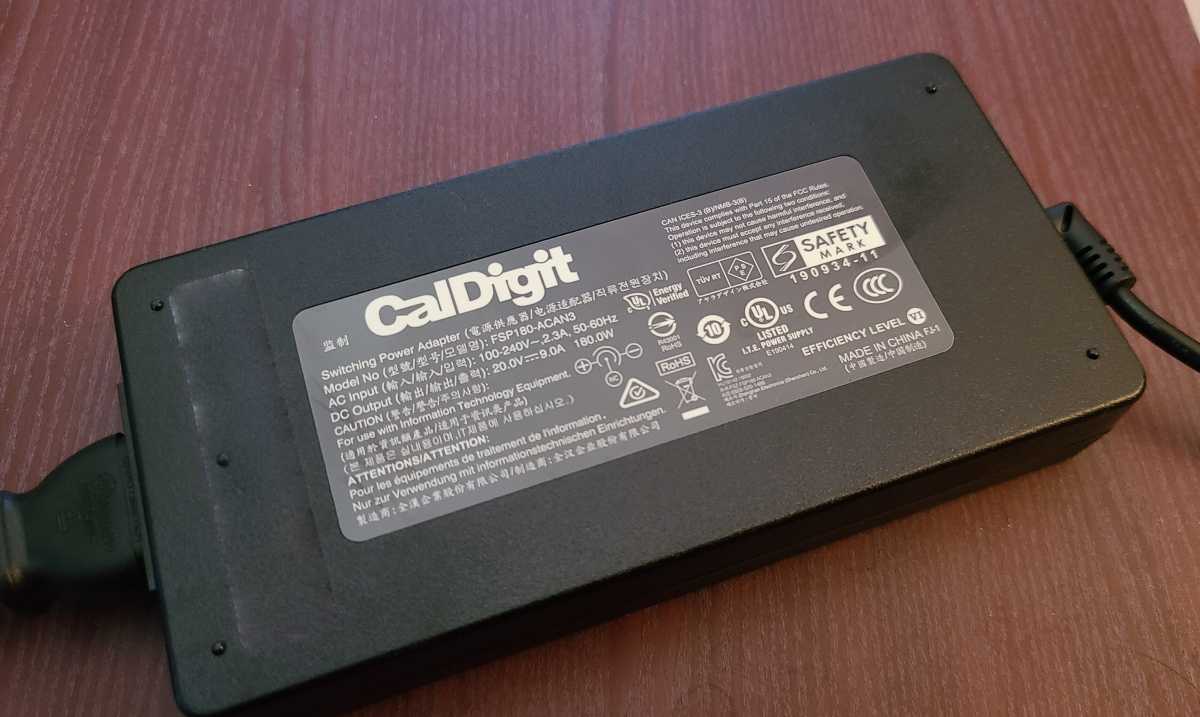
Powered Thunderbolt docks, especially those that power your laptop, can ship with some pretty sizeable power bricks.
Mark Hachman / IDG
There’s one more consideration: the length of the Thunderbolt cable between your laptop and the dock itself. You may have noticed or heard about USB-C ports wearing out on smartphones; a loose or wobbly connector on a Thunderbolt dock can cause a monitor to unexpectedly flicker or lose connection. Consider how much tension will be put on a cable. A Thunderbolt dock that’s dangling from a Thunderbolt port will stress the physical connector. You don’t want that!
If you’re a Mac user who has stumbled across this article, welcome. But please be aware that early Apple MacBook Pros powered by Intel silicon supported up to two 4K displays. The first MacBook Pros powered by the Apple M1 chip only support a single 4K display. Many Mac users have recently left negative reviews on Thunderbolt docks on shopping sites because of this. Buy a PC!
How we test Thunderbolt docks
We’re working from the premise that you’re buying a Thunderbolt dock for its unique ability to connect to two 4K monitors at 60Hz. Lower resolutions should be much easier to run successfully. Our first test simply connected each dock to a pair of 4K/60Hz displays, each of which could accept DisplayPort and HDMI cabling, and made sure there were no visual artifacts at 60Hz resolution.
Second, we checked to see whether the available ports delivered the bandwidth we’d expect, connecting them to an external SSD and transferring a collection of test files over the Thunderbolt cable and port. We also used AJA’s System Test tool to double-check our numbers and test whether read and write speeds were consistent.
Finally, we spot-checked the available power draw of the hubs and ports with a USB power meter, as well as simply connecting them to bus-powered devices to see if they could deliver enough power to allow them to operate.
This story was updated on May 6, 2023 with additional information and recommendations.
For all the latest Technology News Click Here
For the latest news and updates, follow us on Google News.
